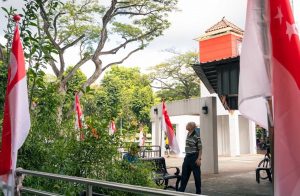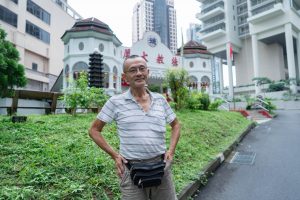Top image: James Carrico
This story first appeared in the Plans In Perspective Substack. Plans in Perspective aims to unpack the yin-yang relationship between society and buildings, places, and artifacts by exploring a wide range of issues in the built environment through writing and other kinds of creative output.
An audio version of this article can be found here.
After the bigwigs finish orating and negotiating at events like COP26, do topics like gas streetlights or ceremonial burnings come up in conversation over evening cocktails? One may never know, but it does strike me that billions around the world may interact with environmental policy with these kinds of things top-of-mind.
It is in fact the second example that is the focus of this article. The timing feels right, as a month ago, April 5th, was the Qingming Festival.
ADVERTISEMENT
Other sources can fully explain what exactly this holiday is, but here’s an attempt to do it briefly: Qingming is a day of observance in Chinese culture when families traditionally visit the graves of their relatives.
During these visits, the graves are tidied up, various offerings (usually in joss paper form) are lit on fire, and families spend the rest of the day relaxing together. The belief is that burning things conveys material goods to the spirits of the departed, who are thought to have some of the same needs as the living.
For example, fake paper money is burned so ancestors have cash in the afterlife. Other things like paper phones, cars, and even little houses and buildings and whole platters of random stuff may be conveyed (burned). Sometimes food is involved, too.
Originating from China, this practice has a history that amazingly traces back to events that happened over 2,000 years ago.
Importantly, the burning of various flammable substances in various Asian cultures and religions is not unique to Qingming festival, nor is it exclusively done at cemeteries or columbaria. Land is so valuable and so limited in Singapore that graves are often exhumed after a prespecified number of years.
This is done either to release the site for the next generation of recently departed, or in some cases to make room for property and infrastructure development. Regardless, the practical realities of land scarcity means that some families have come to honor their relatives with ancestral tablets that are kept in columbaria or at home. In that case, Qingming offerings may simply be burned near houses or apartments or other meaningful places.
Burning for religion
The summertime Hungry Ghosts Festival is another holiday that involves copious artifacts of the combustible and non-combustible variety.
During the Hungry Ghost Festival, spirits of the dead are believed to take a vacation from heaven or hell to come visit the living world for a few weeks. Various paper goods are burned so the ghosts can have a nice time during their break from wherever they might be visiting from.
Other holidays and ceremonies too numerous to count feature similar rituals. It can happen during Chinese New Year celebrations, but also at more somber ceremonies like funerals. Burning offerings are also done on days that have meaning in Buddhist and Taoist traditions, usually to honor various gods.
Now, Buddhism and Taoism are two different religions. But from what I’ve gathered, they have evolved to share some traditions, especially in multi-cultural, Chinese-diaspora contexts like Singapore where mixing is inevitable.
Interestingly Singapore, where ethnic-Chinese are the majority, can be thought of as a kind of time-capsule that allowed the continuation of traditions from pre-cultural revolution China. That’s because Singapore’s 1965-published constitution protected freedom of religion, in contrast to Mao’s atheistic China which sought to eradicate non-secular practices.
It’s worth mentioning that Buddhism and Taoism are to some degree making comebacks in present-day China, but the non-religious Qingming practices are much more prevalent there. By comparison, Buddhist and Taoist traditions are celebrated more emphatically in places like Taiwan, Singapore, Malaysia, and many other places with robust overseas Chinese populations.
ADVERTISEMENT
At any rate, this can all get complicated fast, at least to the uninitiated foreigner. I spoke with many Singaporeans while investigating this topic, and was cautioned against generalizing.
Many families and individuals have unique beliefs and traditions that may not fit neatly into a Wikipedia-style narrative. For the sake of clarity, this article aims to synthesize things in an accessible way at the risk of losing nuance.
Placing complexity aside for a moment, the basic idea is that in Singapore, for a wide range of reasons rooted in a wide range of cultures, things are burned in a ceremonial fashion in various places. And the act of doing so has a great deal of emotional, familial, personal, and cultural significance to many.
With that in mind, I think there are two things worth discussing in the context of Plans in Perspective. First, the way that public space uniquely figures into all of this in land-scarce Singapore. Second, environmental and health concerns vis-à-vis increasing regulations and what that may signal for the future continuity (or discontinuity) of ancient traditions.
Tradition vs Environment
Let’s start by turning our attention to metal barrels.
Spend a few months in Singapore, and you will invariably witness flames of respectable reach emerging from these at some point. Some fires are large enough to cook a burger on.
Walk around a Singaporean residential area outside the central business district, and you are bound to spot several of these barrels. They’re usually on or nearby sidewalks and streets (for fire truck access?).
The barrels, which range in appearance from utilitarian to ornamental to large-industrial, have been placed around residential areas to accommodate the multi-faceted practices of burning offerings. Their placement and procurement are supposedly managed by local town councils, but can apparently be purchased by anyone for a few bucks.
If this sounds a little bit chaotic, just imagine how it was a few decades ago. Older residents tell me that’s when there were no bins of any kind, and things would be burned at random locations inside the open-air ground floors of buildings or in the grass just outside.
Evidently, uncontained blazes still occur on occasion. That’s partly because to this day, the published government stance, according to the National Environment Agency of Singapore, is that (emphasis mine) ”The burning of joss paper is a religious practice and not regulated by any law”. Nevertheless, residents are advised to burn joss paper in either a proper receptacle for burning, containers provided by the Town Councils or purpose-built pits provided in some HDB estates.
Container or not, a familiar tension between tradition and environment has emerged. Despite recent common-sense tactics like installing metal bins with a capped design, the burning of joss paper and other combustibles clearly puts out a hefty amount of localized pollution.
Singaporeans and expats alike are quick to bring this up. They resigned themselves with a sigh to this year’s upcoming Hungry Ghost Festival, which is apparently when the air is smokiest. Some described smells and soot lingering inside bedrooms for weeks.
Health concerns like these have led China and Taiwan to seriously consider or put outright bans on burning, at least in urban areas. For Singapore’s part, there is a sense that its government will not quickly pivot from their comparatively laissez-faire policy anytime soon.
But that doesn’t mean highly contested debates haven’t happened at the grassroots level. One thread on Reddit saw a passionate discussion following the post of a lengthy essay outlining various health and environmental concerns attributed to the practice of joss paper burning.
The 4th-gen joss stick makers
All of this discussion around burning would not be complete without some attention to the fascinating cousin of joss paper: the joss stick. And it turns out that this is another contested artifact in the march toward ever more sanitized environments.
That became obvious to me after a delightful conversation with Steven and Albert Tay, owners of Tay Guan Heng Joss Stick Maker. The Tay’s run the last operating giant joss stick making shop in Singapore. Unlike the small sticks that look like sparklers that are widely available, the Tay family makes huge, intricately detailed joss sticks that would be considered works of art in their own right if it weren’t for the fact that they’re usually destined for incineration.
And if their present day creations are huge, they were once gargantuan by comparison.
Following regulations in the 90’s, joss sticks have been limited to 1.8 meters. But the Tay’s showed me some pictures of some of the old ones, which could reach six meters and must have been truly spectacular in person.
But the size limitations severely chilled demand for giant joss sticks and while there were once five companies in Singapore that made them, Tay Guan Heng is the only one open for business today.
To hear Steven and Albert’s life stories paints a somewhat tragic picture of the craftsman in the 21st century.
Two of eight children, they grew up in a colonial-era shophouse, the fourth generation in their family to learn the giant joss-stick-making craft. As the name of the building type indicates, the “shop” and the “house” were at that time contained under one roof. Family and trade, domesticity and commerce were neatly bundled into one slice of city fabric.
But contemporary zoning in Singapore doesn’t really allow such coexistences anymore. The brothers have since separated home and shop, with Tay Guan Heng now located in an industrial building in the Singaporean heartland.
Albert noted the lack of interest in the craft by younger generations, and partly attributed it to this spatial divorce. All of this seems somewhat akin to the increasingly tenuous existence of multi-generational customs and traditions more broadly, at least in the Singaporean and U.S. contexts.
But on the day of my visit, the men were busy churning out 1.8m joss sticks for upcoming holidays. They inform me of a temple that will burn several of them in a couple weeks, and I definitely plan to go see the sticks meet their maker once again, as it were.
Some of TGH’s biggest customers of giant joss sticks are temples, who often burn them to honor various gods on various holidays throughout the year. But as temples often have a porous and direct relationship with the urban streetscape, they are increasingly coming under scrutiny for their burning practices.
Albert was sensitive to the fact that increasing restrictions could once again deal a blow to their livelihood. Fortunately, the Tay’s are not without business acumen, as they have partly pivoted to crafting other objects.
You can, for example, now order a remarkable (though, noncombustible) nativity set that beautifully combines eastern and western motifs in ways that would probably occupy scholars of a certain expertise for weeks.
Yet wandering around their shop, one can’t help but enter into a slightly melancholic state when realizing that its raison d’etre, giant joss sticks, are unlikely to see a fifth generation continue their production. A slow, decades-long, multipronged onslaught of regulations has slowly eroded the ability of this expertise in craftsmanship to sustain itself through another cycle of time.
All of this leads to the familiar realization that when environment and public health and deep-seated tradition come into conflict, the interaction is far from simple. It’s tempting to approach the whole issue the way a member of the laptop/consulting class would. That is, as a series of conflicting interests between different stakeholders that can be resolved in some sort of quantitatively optimal way.
Things like the Reddit essay linked above take this approach; the thing almost reads like a McKinsey report (this is both critique and compliment). But the discussion it stimulated nevertheless broadly acknowledged the sensitivity and complexity involved with this subject.
Millennia-old traditions don’t lend themselves neatly to the tyranny of sticky note workshops or flow chart frameworks.
Some perspective is in order. One of the people I spoke with on these matters was Emily Lu, a fellow Fulbrighter and first-generation American.
Emily has strong memories of participating in Qingming traditions in Yangzhou with her relatives. She recalled folding little paper boats in advance of the gravesite visit, a skill passed down by her aunt.
I also spoke with many individuals who said they had occasionally joined their families in various rituals to honor ancestors. Some were ambivalent about whether or not they would pass down customs to their offspring, and a few were actually certain they wouldn’t.
That was not the case with Emily, who hopes to find ways of continuing the tradition over the years in the U.S. In her case, it might involve more humble forms of fire, like candles. If this is any indication of at least one possible future for these practices, it would seem that the proverbial flames of tradition are likely to stay alive, albeit less dramatically than before.
For now, encounters with burning barrels will bring a smile to my face, rather than a hand to cover my nose.






